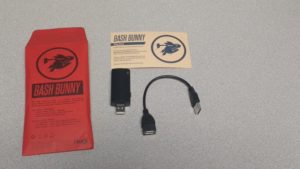Sorry for the late edition. I got my days mixed up, yesterday. This week had two Mondays in it, as far as my brain could tell. I got the short end of the stick on that.
This week, we’re going very quickly look at the “STORAGE” Attack Mode on the Bash Bunny.
This is what it looks like when I plug my Bash Bunny into a Linux Mint 17 laptop:
[ 4966.425800] usb 3-1: new high-speed USB device number 2 using xhci_hcd
[ 4966.444695] usb 3-1: New USB device found, idVendor=f000, idProduct=fff0
[ 4966.444707] usb 3-1: New USB device strings: Mfr=2, Product=3, SerialNumber=7
[ 4966.444713] usb 3-1: Product: RNDIS/Ethernet Gadget
[ 4966.444718] usb 3-1: Manufacturer: Linux 3.4.39 with sunxi_usb_udc
[ 4966.444722] usb 3-1: SerialNumber: ch000001
[ 4966.615123] cdc_acm 3-1:2.0: This device cannot do calls on its own. It is not a modem.
[ 4966.615169] cdc_acm 3-1:2.0: ttyACM0: USB ACM device
[ 4966.615800] usbcore: registered new interface driver cdc_acm
[ 4966.615802] cdc_acm: USB Abstract Control Model driver for USB modems and ISDN adapters
[ 4966.618621] usb-storage 3-1:2.2: USB Mass Storage device detected
[ 4966.618795] scsi6 : usb-storage 3-1:2.2
[ 4966.618891] usbcore: registered new interface driver usb-storage
[ 4971.629404] scsi 6:0:0:0: Direct-Access 0000 PQ: 0 ANSI: 2
[ 4971.629670] sd 6:0:0:0: Attached scsi generic sg2 type 0
[ 4971.630115] sd 6:0:0:0: [sdb] 4194304 512-byte logical blocks: (2.14 GB/2.00 GiB)
[ 4971.630264] sd 6:0:0:0: [sdb] Write Protect is off
[ 4971.630266] sd 6:0:0:0: [sdb] Mode Sense: 0f 00 00 00
[ 4971.630405] sd 6:0:0:0: [sdb] Write cache: enabled, read cache: enabled, doesn’t support DPO or FUA
[ 4971.631847] sdb:
[ 4971.632512] sd 6:0:0:0: [sdb] Attached SCSI removable disk
[ 4973.119396] FAT-fs (sdb): Volume was not properly unmounted. Some data may be corrupt. Please run fsck.
When we put a payload into Attack Mode STORAGE, the drive presents a 2G drive to the system. This looks just like the drive that gets presented when plugging the Bash Bunny in via Arming Mode.
This is useful for some attacks, such as what the TwinDuck firmware the USB Rubber Ducky provides, where we use both STORAGE and HID Attack Modes, then use Ducky commands to bring up a command prompt of some sort, type some commands to figure out where our drive is at, and drop files to that location. This kind of attack is becoming less useful with corporate policies that prevent the use of USB thumb drives, these days, but the Bunny has another way to do this same kind of thing. We’ll look at that next week when we introduce the networked attack modes.
